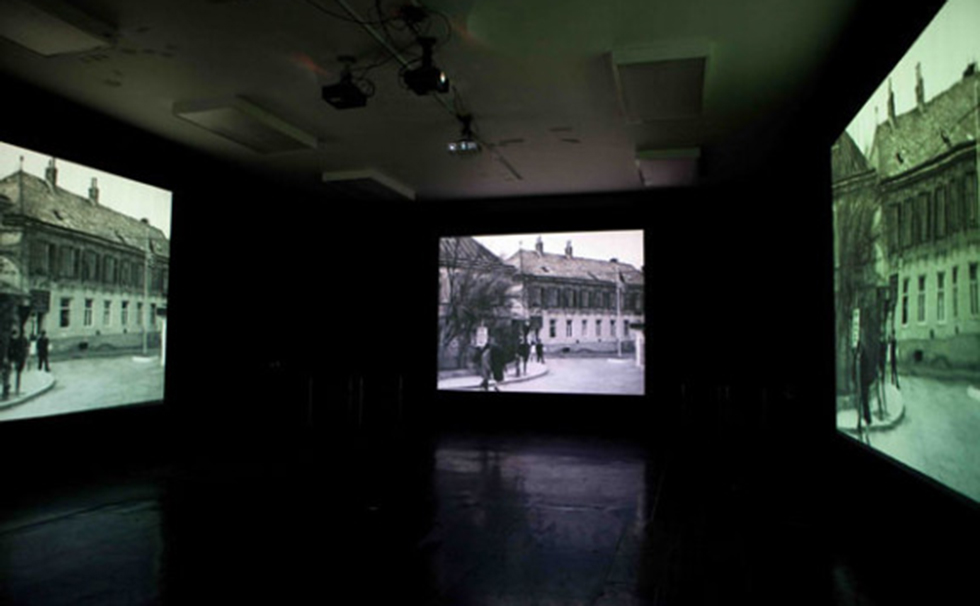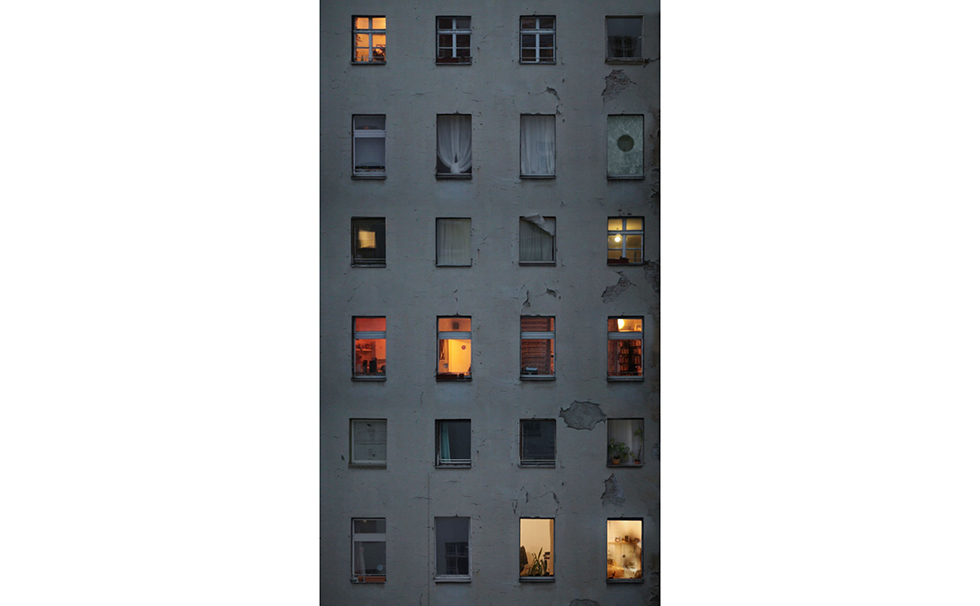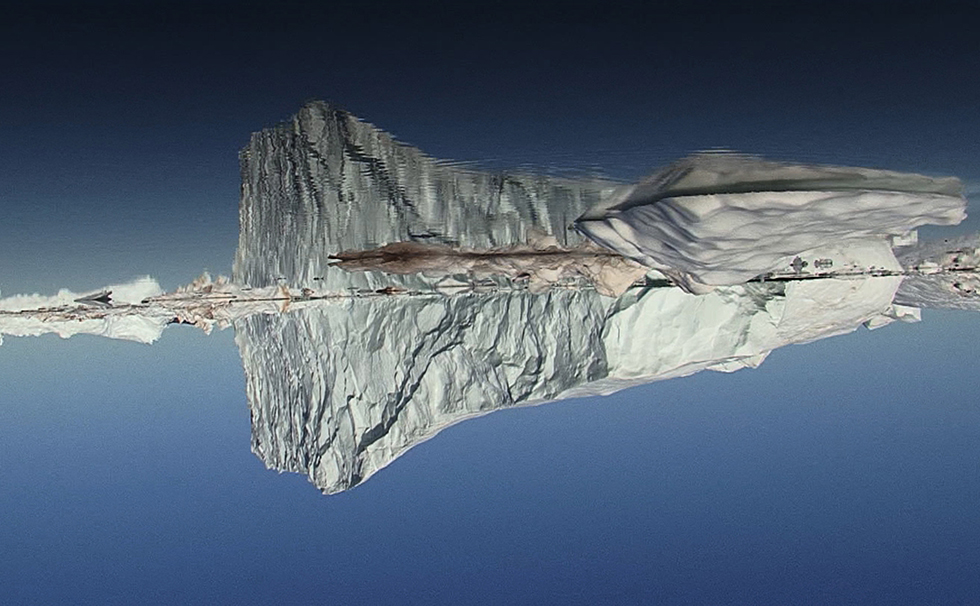3/3/3/13

3/3/3/13
FEBRUARY 28 – MARCH 28, 2013
Three video presentations for three weeks in March – was conceived specifically as an all-video exhibition. While the viewer will likely find commonality in the works’ approaches and themes, the videos are distinct, occupying very different sensory and emotional spaces. With one taking a prolonged look at the wall of a building with its crepuscular inhabitants glimpsed through windows (Seitenflügel), another concerning the grim vitality of existential struggle (Where is the Black Beast?), and the third depicting a beautiful and menacing polar seascape (Kivanrepu), perhaps these three works are entirely consonant with the indecisively damp and mercurial nature of late winter.
Simon Lee and Algis Kizys’ Where is the Black Beast? was created by stringing thousands of found photos together into a visual narrative based on the poetry of Ted Hughes. This “collaboration” with hundreds of anonymous photographers realizes the intensity of Hughes’ poetry in a cinematic form.
Where is the Black Beast? begins with Lineage, a poem that abridges The Book of Genesis into 21 lines and from which the protagonist Crow emerges. A journey then begins that takes us from Oedipus’ familial catastrophe to Crow’s mad battle with the sun.
This four-screen video projection is a collaboration with Algis Kizys, who composed the soundtrack. “The process of editing the film was a constant negotiation between sound, picture, poetry and spoken voice,” Lee says. Eventually, ten distinct ‘chapters’ emerged, seamlessly combining the unidentified, unnamed figures in those photos with the primeval angst reflected in Hughes’ poems.
As Lee relates: “I read Crow: The Life and Songs of the Crow, by Ted Hughes, at sixteen. The visceral darkness of the imagery, set in a familiar landscape, resonated deeply with my own dark view of the world. I saw Crow as a story of a civilization with an impending apocalypse, mythologized through twentieth century imagery. Rich visual images saturate the poetry, and their rhythm and mechanics begged to be translated into film. In Leonard Baskin’s drawings of an obdurate crow fixed solidly to the ground, hubris reigns. These drawings are not, in fact, illustrations for the poetry, but the original visual inspiration for Hughes’ writing. Later, upon becoming an artist, I knew I wanted to return to that text. I wanted to somehow translate those dark, eerie metaphors and phrases back to a visual language, this time using the conventions of cinema.”
Seitenflügel, a new single-channel video work by Eve Sussman and Simon Lee created in Berlin, takes the psychologically fraught context of Hitchcock’s Rear Window as its point of departure. The artists trained their camera on the exterior of a generic apartment building as day slides into night. Seitenflügel captures glimpses of mundane fragments and implied narratives in the lives of the inhabitants. The work forefronts the voyeurism inherent in urban environments, implicating us as viewers – something we may be growing less averse to in the age of willful self-exposure and “oversharing.”
Established from a single, axially static viewpoint, Seitenflügel plays on the idea of the rigorous structure of the grid so prevalent in modernist Germanic art. The very title Seitenflügel, meaning “side-wing” hints that the part we are privileged to view is just one wing or module of a larger building which we could easily extrapolate, fractally, from the visible segment. The uniformity of the structure’s unseen plan is manifested in the regular punctuations of its undecorated fenestrations. But the facade also reveals flaking paint and ruptured stucco; the effects of entropy that encumber any system, or edifice, over time. The building’s gridded surface also acts as a foil for the more organic goings on – the quotidian arrivals and departures and actions – of its inhabitants, who seem like organisms populating a system not entirely of their own design but one more-or-less suited to their purposes; a far cry, perhaps, from the ideals that led to the creation of such a structure.
Marek Ranis’ video Kivanrepu, a formally simple, visually ravishing but relentlessly disquieting work from the artist’s Polar Series, is the result of his investigation of “how the perception and understanding of large-scale global events is shaped by our personal experience or our immediate social, cultural or geographical environment…a relation between the Polar landscape of northwestern Greenland and the NASCAR sport racing / car culture becomes a dominant motif, through which I explore the interconnectedness of seemingly distant places, events and phenomena.”
Ranis further explains, “The German philosopher Max Dessoir recognized five elements defining aesthetic experience: the beautiful, the sublime, the tragic, the ugly and the comic. In Kivanrepu, the surreal masses of ice gliding in a remote Arctic universe bring to mind familiar images from sci-fi films or space travel. But here, they are accompanied by an oppressive industrial sound of internal combustion engines, running in the endless loop of stock-car racing. Romanticized in the 19th century, the Polar landscape, menacing yet beautiful and glorified by early explorers, brings undertones of conquest. Our desire to discover is ultimately followed by a desire to posses and control. Our mere presence in such places leaves footprints and alters them.”
About this video, the artist says “movement is extremely important to me.” The viewers are made to seem “like immobile or passive observers of rapid movement and rapid changes beyond our control.” The video employs a similarly circular composition,”with no beginning and no end; we are transported into ongoing drama… both the super-fast and glacial-speed transitions from one state to another…are for me the essence of the challenge that we face trying to comprehend civilization and ecology.”
Kivanrepu is part of a series of works produced as a result of an artist-in-residence experience in Greenland in 2009. It was filmed in the Upernavik (Kivanrepu is Upernavik spelled backwards) Ice Fiord in northwestern Greenland.
Curator
Paul Bright, Charlotte and Philip Hanes Art Gallery Director
Reception
Thursday, February 28 5-7 PM
Related Programs
Related Links
- Dark Poem Comes to Cinematic Life in Curtained Chamber (Yes! Weekly)
- Charlotte and Philip Hanes Art Gallery Presents Series of Video Exhibitions (WFDD – TAUC)
- 3/3/3/13 Press Release
Additional Images




